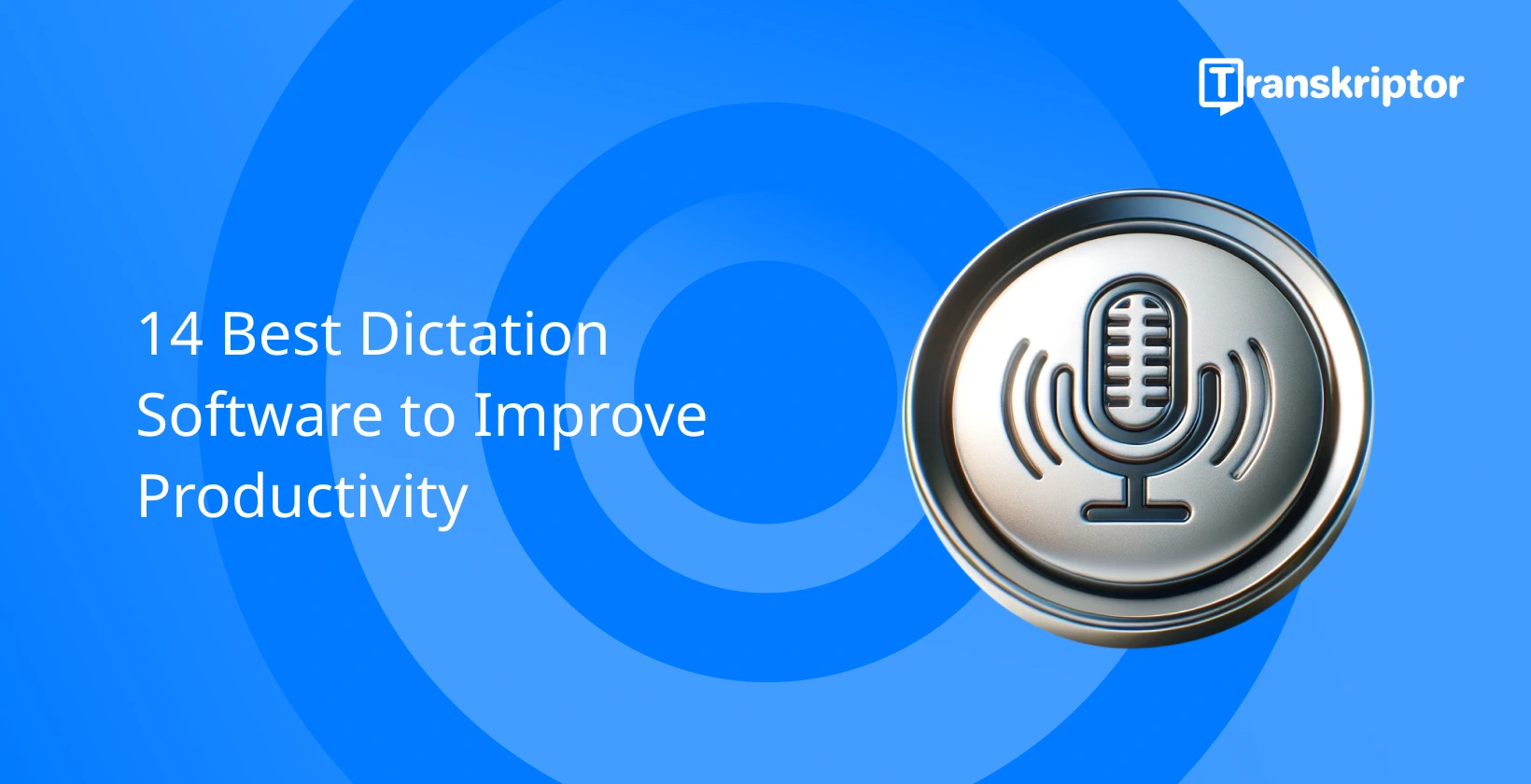Dictation software offers a multitude of advantages that cater to various user needs. Dictation software improves productivity, accessibility, and hands-free operation, allowing users to swiftly and efficiently compose text-based content.
It has certain disadvantages while dictation software has various advantages. Users encounter a learning curve, variability in accuracy, editing challenges, limited offline functionality, and privacy concerns when using dictation software.
In the quest to choose the ideal dictation software, a structured approach makes all the difference. It contains the specific needs and objectives, ensuring compatibility, accuracy and language and so on.
14 best dictation software to improve productivity are listed below.
- Transkriptor : An online transcription software that utilizes AI for quick and accurate transcription, along with translation capabilities.
- Dragon NaturallySpeaking : Known for its precision, Dragon NaturallySpeaking is a professional-grade dictation software offering adaptability to unique vocabularies.
- Google Docs Voice Typing: A tool provides real-time transcription and supports voice commands for editing in Google Docs .
- Microsoft Dictate: Seamlessly integrates with Microsoft Office applications, making it a choice for professionals.
- Apple Dictation: Ideal for Apple device users, offering offline functionality and privacy-conscious transcription.
- Otter . AI : Utilizes machine learning for transcription, offering a competitive free-forever plan and reducing the need for manual note-taking.
- Speechmatics : Known for its ability to handle large volumes of audio data, making it suitable for enterprise-level usage.
- Nuance Dragon Anywhere : A mobile dictation app with ease of use on mobile devices, but limited integration with other applications.
- Braina : An AI virtual assistant and speech recognition software that provides hands-free control.
- IBM Watson Speech to Text: IBM offers tailored language models and robust security features, suitable for various applications.
- Windows 10 Dictation: A built-in feature of Windows 10, offering offline functionality and system-wide integration.
- Dragon Anywhere : A mobile dictation and voice recognition application that excels in creating text-based content.
- Gboard : Google's mobile virtual keyboard with a user-friendly and customizable interface.
- SpeechTexter : A free online tool for quick note-taking through dictation, available on the web and Android devices.
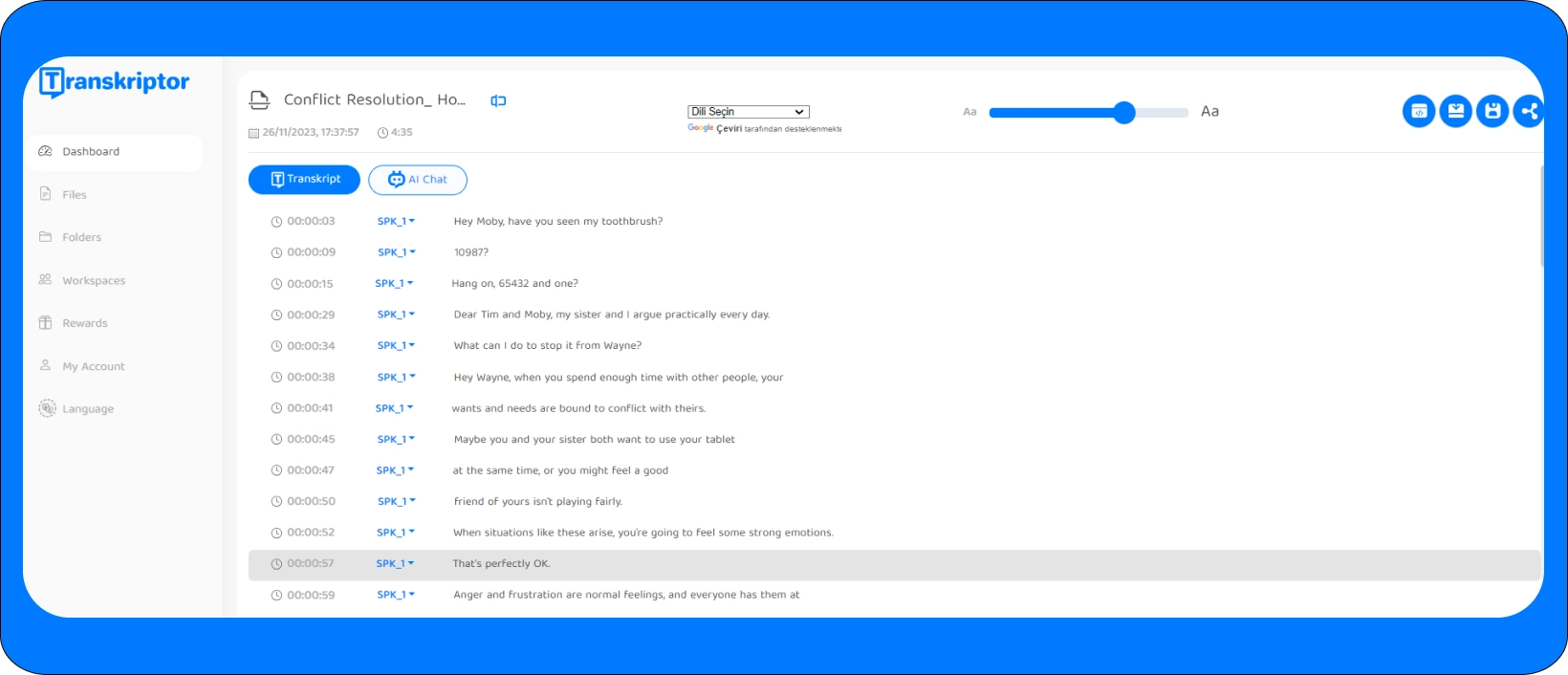
1. Transkriptor
Transkriptor is an online transcription software that uses A.I. for quick and accurate transcription. Users are able to translate their transcripts directly from the Transkriptor dashboard with a single click.
Users consistently praise Transkriptor for its ease-of-use, accuracy, and speed. Transkriptor learns speech patterns, ensuring accuracy of up to 99% when converting speech to text. Transkriptor is also highly recommended for its translation services. The platform offers transcription in more than 100 languages, serving a global user base.
Users can easily record their voices directly on the platform or upload pre-recorded audio and video files. Once uploaded, Transkriptor takes over the process, quickly transcribing the content into text. This service is not only about ease of use but also about speed, providing fast transcription services that save valuable time for its users.
Additionally, Transkriptor enhances its accessibility by allowing users to copy and paste links from popular cloud storage services like OneDrive , Google Drive , and video platforms such as YouTube . By doing so, users can obtain transcripts of content stored on these platforms without the need to download and re-upload files, streamlining the process even further.
Whether you work in law, medicine, academia, or another profession, Transkriptor offers a reliable, rapid, and accurate transcription service that fits a wide range of requirements.
It has affordable pricing options. Users streamline transcription and translation by centralizing all transcripts in one location. Transkriptor offers 90 minutes free transcription, try it for free!
2. Dragon NaturallySpeaking
Dragon Naturally Speaking released by Nuance allows users to convert spoken words into written text with precision. It provides accessibility solutions and adjustments for unique linguistic vocabulary.
It is recommended best for professional users seeking improved performance. Users like Dragon NaturallySpeaking for its adaptability to unique vocabularies and accessibility features.
Dragon NaturallySpeaking offers various pricing plans ranging from $14.99 to $500, each with specific features.
Dragon NaturallySpeaking offers unparalleled flexibility in dictation and transcription, accommodating various linguistic nuances.
Users must purchase desktop software separately.
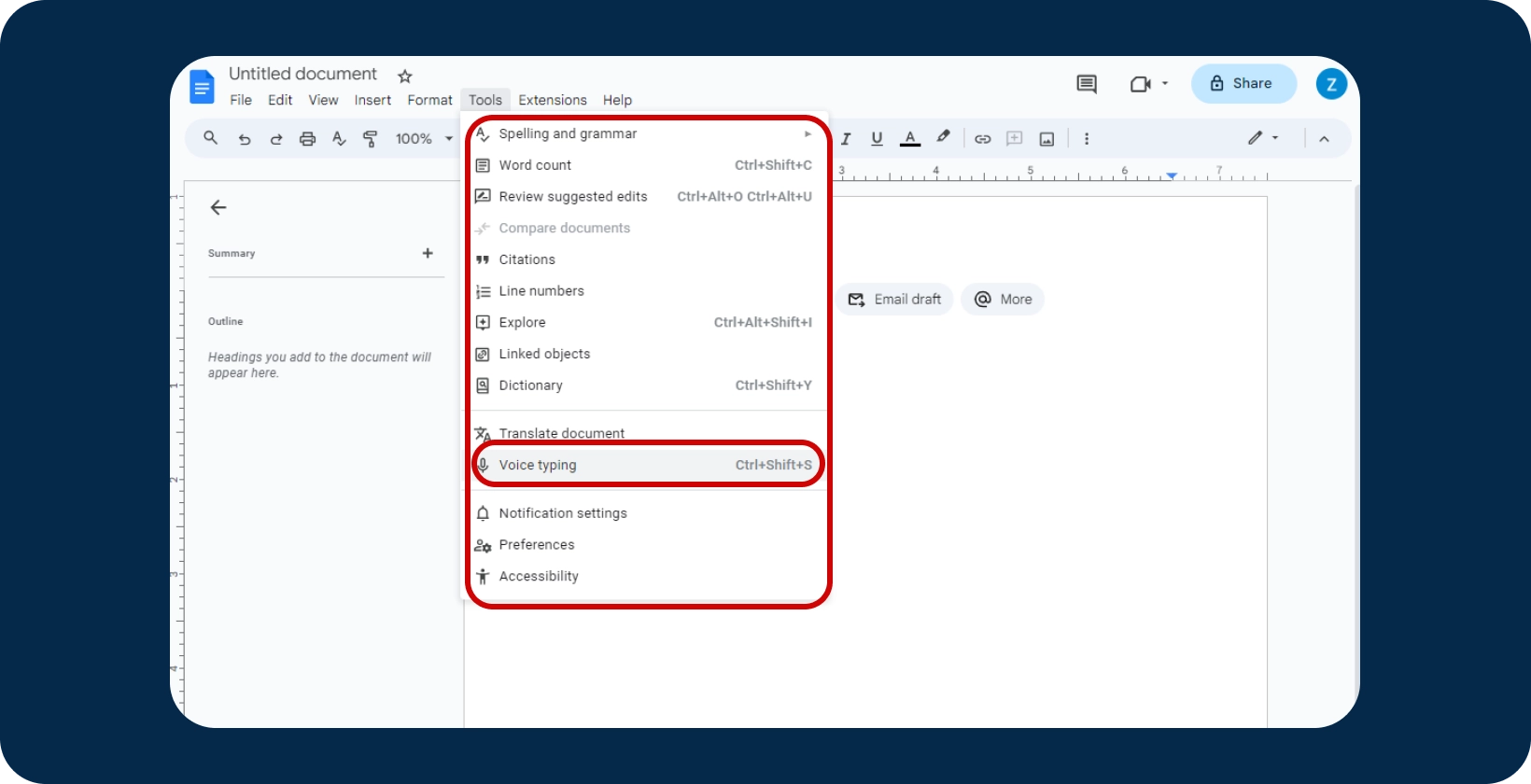
3. Google Docs Voice Typing
Google Docs Voice Typing lets users speak and turn their words into written text in Google Docs . It provides real-time transcription, supports voice commands for formatting and editing, and improves accessibility for users with disabilities.
It is free for Google account users. This makes it a highly recommended software for converting speech to text and creating documents.
Google Docs Voice Typing integrates with Google Docs , which enables online editing.
There is limited offline use.
4. Microsoft Dictate
Microsoft Dictate is a voice recognition and transcribing software application created by Microsoft . Users are able to be more productive by speaking and having their words converted into written text in Microsoft Office apps. Microsoft Dictate garners positive user feedback for its ease of use and seamless integration.
Microsoft Dictate is highly recommended, especially for individuals and professionals who extensively use Microsoft Office applications for their document-related tasks.
Microsoft Dictate is a free add-in for Microsoft Office applications, similar to Google Docs Voice Typing. There is no installation or setup required. It incorporates all Microsoft 365 subscriptions.
There is limited offline use. It is not available on other operating systems except Windows users.
5. Apple Dictation
Apple Dictation is a voice recognition tool. It allows users to speak instead of typing. It works in various apps and text fields. The users see their speech converted as they speak through Apple Dictation by real-time transcription to the text.
Apple Dictation is generally free and is a default feature for users of Apple hardware. Apple Dictation is available in applications such as Messages, Notes, and Mail. It provides ease of offline use.
It is only available on Apple devices and ideal for infrequent use.
6. Otter . AI
Otter . AI is a machine-learning-based voice-to-text transcription software. Otter . AI allows users to import audio and video files from the device or record right inside the application itself. Otter . AI subscription comes with a mobile version of the software, unlike Dragon .
Otter . AI offers 3 subscription plans. Free Plan offers up to 600 minutes. Premium Plan costs $10 USD per user/month. Team Plan is $20 USD per user/month.
Otter . AI offers a competitive free-forever plan. It reduces the need for manual note-taking with its transcription capabilities.
It has limited customer support.
7. Speechmatics
Speechmatics is a tech company in Cambridge, England. They make speech recognition software using neural networks and language modeling. Users train the ASR models to recognize specialized vocabularies, industry-specific terms, and accents. Dictation Software is recommended most for its capacity for handling large volumes of audio data.
Speechmatics offers 3 pricing options. Users contact Speechmatics directly for detailed pricing information.
Speechmatics allows users to tailor ASR models to their specific requirements. It is capable of handling large volumes of audio data.
Detailed pricing information is not available.
8. Nuance Dragon Anywhere
Nuance Dragon Anywhere is a mobile app that lets users speak and it turns the words into written text. Users use it to make documents, emails, articles, and other written content. The app learns a custom language and accommodates the user’s voice to achieve better accuracy. Documents created using Dragon Anywhere are synced with cloud storage to access/edit across devices.
Users start with a 7-day free trial, after which a subscription fee of $15 per month is required to continue using the service.
Nuance offers ease of use on mobile devices, making it convenient for on-the-go tasks. It integrates with other applications and services.
Nuance Dragon Anywhere primarily provides dictation within the app, lacking integration with applications. There is limited offline use.
9. Braina
Braina is an artificial intelligence virtual assistant and speech recognition software. Dictation Software is recommended most for its voice-enabled, natural language interface to computers, making it easy to access a range of tasks. Users are able to create their custom voice commands and automate tasks.
Braina comes in both free and paid versions. Braina Pro requires a one-time payment of $79 per year.
Braina provides hands-free control of the computer, enhancing convenience and efficiency. It allows users to personalize voice commands.
The free version of Braina is not available. It offers limited offline functionality.
10. IBM Watson Speech to Text
IBM Watson Speech to Text is an ASR service in the cloud, and it’s provided by IBM . Users tailor language models to specific industries, accents or dialects. Dictation Software is recommended most for its security features to safeguard the privacy of voice data. Please visit the official IBM Watson Speech to Text page for current pricing details.
Users tailor ASR models to meet their specific requirements, increasing accuracy and relevance. It integrates with other IBM Watson services.
The service does not offer a free option. It offers limited offline functionality.
11. Windows 10 dictation
Windows 10 Dictation is a built-in speech recognition and voice-to-text feature integrated into the Windows 10 operating system. It converts spoken words into written text in numerous applications and text fields, with the user speaking the words to the app. Windows 10 Dictation is highly recommended for users who prioritize cost-efficiency.
Windows 10 Dictation is a free feature included with the Windows system. Windows 10 Dictation provides offline functionality. It offers system-wide integration.
The feature has limited voice command capabilities.
12. Dragon Anywhere
Nuance Communications' Dragon Anywhere is a mobile dictation and voice recognition application. It allows users to create documents, emails, and other text-based content on mobile devices. Users train the app to identify specific terms and react to the user's speech for increased accuracy.
Dragon Anywhere offers a free trial period, after which users subscribe at a cost of $15 per month.
Dragon Anywhere allows customization to recognize industry-specific terminology and jargon, improving precision. It provides ease of use on mobile devices.
Dragon Anywhere is primarily designed for mobile use, which limits its compatibility with other platforms.
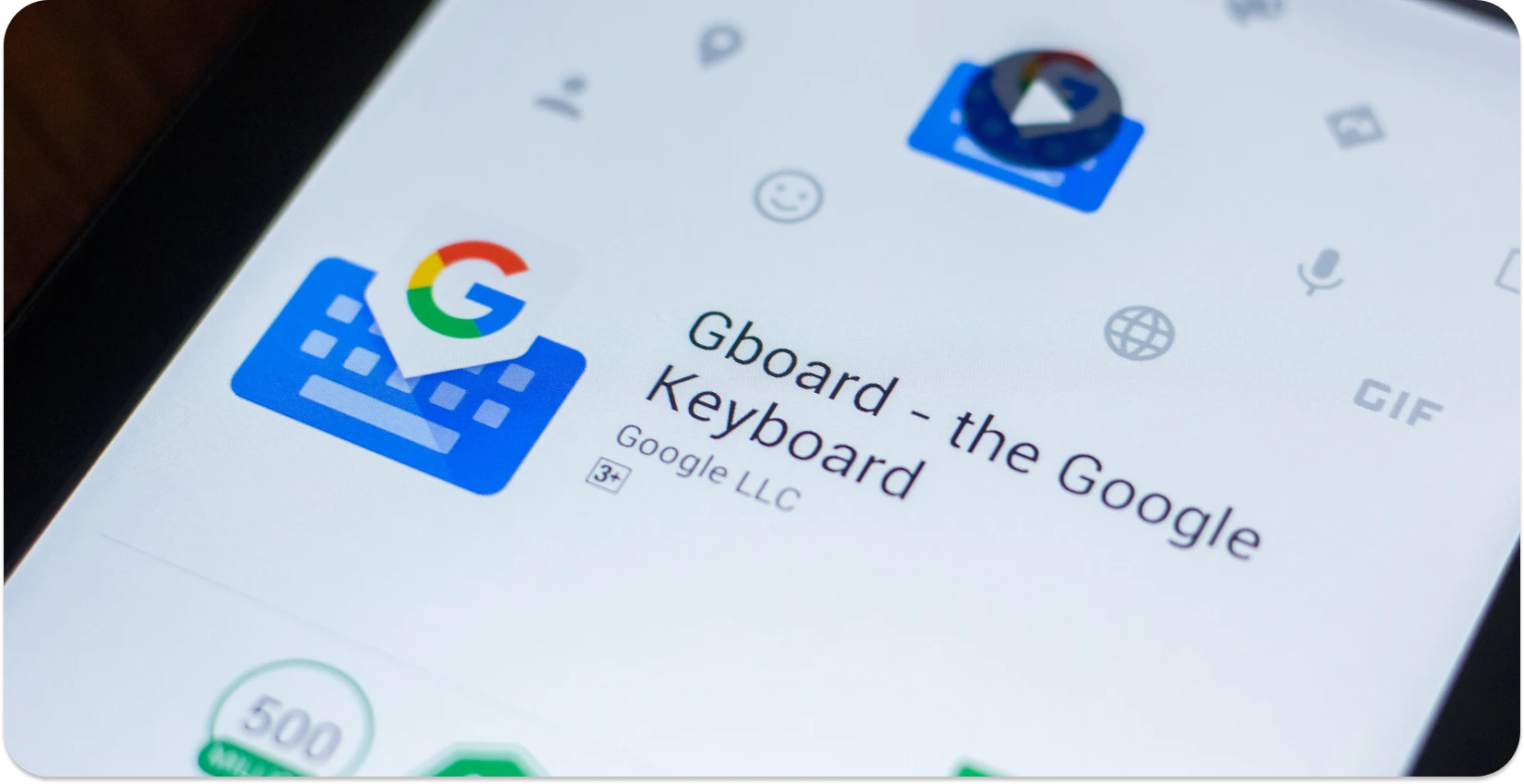
13. Gboard
Google Gboard is a mobile virtual keyboard application developed by Google . It is available for both Android and iOS platforms. Gboard is a keyboard app that offers many features and is easy to use. It has themes, different keyboard layouts, and customizable preferences. Dictation Software is highly recommended for its user-friendly interface. Gboard is typically free to use and does not require a separate purchase.
Gboard offers a user-friendly and customizable keyboard experience. It provides ease of use on mobile devices.
Gboard offers limited offline functionality.
14. SpeechTexter
SpeechTexter is a free tool that allows users to dictate words and transform them into text for quick note-taking. Users access it online or through an Android app. SpeechTexter supports multiple languages, allowing it to be used by people all around the world. SpeechTexter is available for free for basic use like many online speech recognition software.
SpeechTexter is typically available for free for basic usage.
SpeechTexter provides a user-friendly and straightforward interface for speech-to-text conversion. It offers ease of use on mobile devices through its Android app.
SpeechTexter lacks a desktop application, limiting its compatibility with desktop platforms. It is not available as an app for Apple devices.
What is Dictation?
Dictation refers to the process of vocally stating a spoken word, sentence, or text, then transcribing this on paper or a digital platform. Dictation refers to speaking into a microphone or other input device, and software turns spoken word into text. It’s helpful for individuals who experience typing challenges, and/or desire to boost their productivity.
How to Choose the Best Dictation Software?
To choose the best dictation software, follow the steps below.
- Define the needs and goals. Decide on what specifically to accomplish with dictation.
- Consider compatibility. Make sure that the software works on the operating system or hardware.
- Assess accuracy and language support. Check how accurate the software is at recognising and transcribing the voice and check what languages it supports.
- Evaluate adaptability and training. Figure out if the software starts learning the voice for better recognition.
- Check integration and compatibility. Check that the program is able to connect with the other tools you use.
- Assess the user interface and ease of use. Select software with a user-friendly and intuitive interface and try out the dictation and editing functions.
- Consider mobility and accessibility. Look for mobile app compatibility and check whether the software is accessible by those with disabilities.
- Examine privacy and security. Research if the software shares or sells voice data without the consent.
- Compare cost and licensing. Determine the pricing model for each dictation software.
- Utilize trial periods and user feedback. Use free trials to see if the software works for the needs and read user feedback.
- Investigate customer support and updates. Verify the accessibility and response time of customer support.
- Consider scalability. Evaluate the software's scalability options if planning to expand the usage.
- Check backup and export options. Examine how the software handles dictation backup and recovery. Check that one simply exports the transcriptions to different file formats.
- Stay informed about future trends. Watch out for new developments in dictation technology such as additional features.
What is the best Dictation Software for Mac Users?
The best dictation software for Mac users is Dragon NaturallySpeaking . It has a specific Mac version, ensuring compatibility with macOS while this software has always been linked with Windows . The best dictation software for Mac users distinguishes itself through high transcription accuracy, making it perfect for professionals and those who value exact dictation. Its easy-to-use interface, integration with popular Mac programs, and dependable support and updates cement its place as the top choice for Mac users.
What is the best Dictation Software for Microsoft Users?
The best dictation software for Microsoft users is Microsoft Dictate. It seamlessly integrates with Microsoft Office applications, including Word, Outlook , and PowerPoint . Microsoft Dictate adheres to Microsoft's high security and privacy requirements, protecting voice data confidentiality. The best dictation software for Microsoft users is available as a free add-in for Microsoft Office products.
What is the best Dictation Software for Writers?
The best dictation software for writers is Transkriptor because it offers a fast and automatic transcription with up to 99% accuracy. The best dictation software for writers fits smoothly into writers' workflows via a mobile app, Google Chrome extension, and connectivity with platforms such as Zoom , Microsoft Teams , and Google Meet . This connection improves access and convenience. Transkriptor provides affordable price plans.
What is the best Dictation Software for Lawyers?
The best dictation software for lawyers is Otter . AI . Its transcription accuracy, enabled by machine learning. The best dictation software for lawyers ensures that legal documents and recorded conversations are transcribed authentically and reliably into text.
Otter . AI distinguishes itself with legal-specific features such as the ability to tag speakers, highlight crucial points, and search within transcriptions. Otter .ai's adaptability with platforms like Zoom makes it a practical alternative for lawyers who are always in virtual meetings.
What is the best free Dictation Software available?
The best free dictation software available is Google Docs Voice Typing. Its smooth integration with Google Docs distinguishes it. Users transcribe spoken words into their text easily using real-time transcription and voice commands for formatting and editing.
The best free dictation software is available for Google account holders, making it accessible and affordable.
Is Dictation Software the same as speech-to-text?
No, dictation software is not the same as speech-to-text software, despite their similarities. Users speak into a microphone, and dictation software transforms their spoken words into written text. On the other hand, speech-to-text technology encompasses a broader range of applications beyond dictation. It includes functions such as voice commands and real-time captioning.
How to Transfer Text with Dictation Software?
Transferring text using dictation software is a streamlined process. First, launch the dictation software, whether it's a standalone dictation application or an integrated feature within a word processing program.
Next, select the text input area. Start dictation by clicking the microphone icon, pressing a key, or using a voice command like "Start dictation." When dictating, it's crucial to speak clearly. Alternatively, you upload an audio or video file.
After dictating, review the transcribed text for accuracy. Users download the text by clicking the appropriate function, such as "Save," "Send," "Insert." Lastly, save the document or submit the text as dictated by the specific application.
How to Edit Text Using Dictation Software?
To edit text efficiently using dictation software, it's important to understand the basic steps. Begin by activating the dictation software, which can usually be done by clicking a microphone icon. Navigate to the text.
Use specific voice instructions to issue editing commands. For instance, "Select the last paragraph" or "Delete the word 'error.'" Dictation software recognizes and executes these commands accurately. Simply dictate the revised or replacement text as needed when making text changes. For example, "Replace 'happy' with 'joyful.'"
Review the text carefully to ensure it accurately reflects the changes after making edits. Lastly, follow the specific application's instructions to save the document or submit the text.
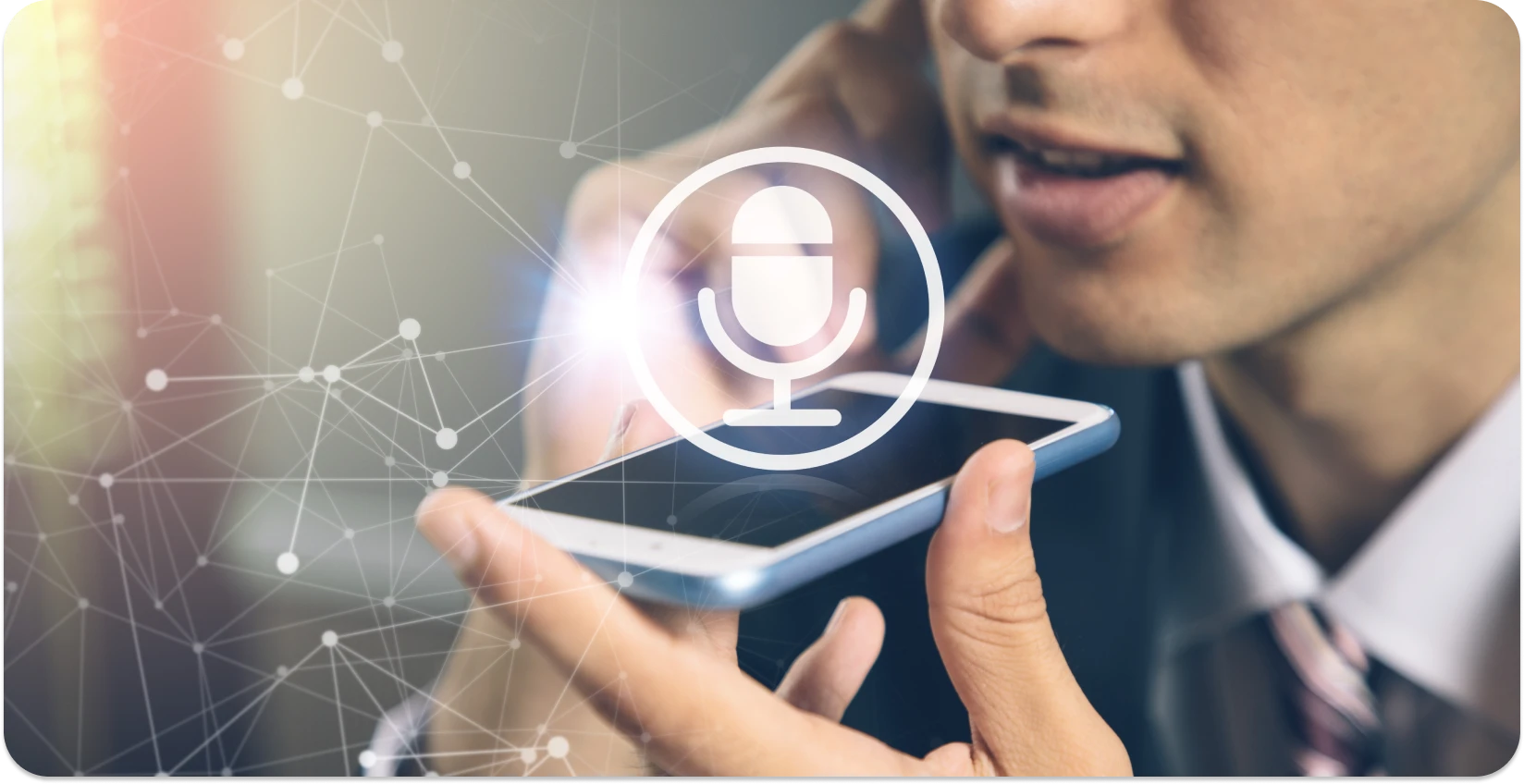
What Role does Speech Recognition Technology Play in Dictation Software?
Speech recognition technology is essential in dictation software because it provides the foundation for converting spoken words into written text. Speech recognition technology improves accessibility for people with impairments by allowing them to interface with computers and devices.
Speech recognition dictation software is fast and productive. It supports multilingual input, customization for certain vocabularies, accents, and industries, and the ability to perform voice commands for various device tasks.
What are the Advantages of Using Dictation Software?
The advantages of using dictation software are listed below.
- Increased Productivity: Dictation software accelerates the process of translating spoken words into text quickly.
- Accessibility: Dictation software allows users with disabilities to interact in an accessible manner.
- Hands-Free Operation: Users use their devices without using their hands, decreasing the requirement for manual typing and allowing for multitasking.
- Multilingual Support: Many dictation software solutions support different languages, making them useful to consumers worldwide.
- Customization: Users tailor the software to recognize industry-specific terminology, enhancing accuracy in specialized sectors.
- Integration: Many dictation software products link easily with other software and apps, allowing for convenient use in a variety of settings.
What are the Disadvantages of Using Dictation Software?
The disadvantages of using dictation software are listed below.
- Learning Curve: Users need time to get used to dictation software, and learn voice commands.
- Variability in Accuracy: Accuracy depends on factors such as background noise, accents.
- Editing Challenges: Editing material dictated by software is more difficult than typing directly.
- Limited Offline Functionality: Its usability in offline contexts is limited.
- Privacy problems: Dictation software generates privacy problems.
Is Dictation better than Transcription?
No, dictation and transcription are not better or worse than each other. They serve different purposes and have distinct advantages and disadvantages.
Dictation excels in situations where real-time conversion of spoken words into text. It is faster, making it suitable for tasks like note-taking during meetings or quickly generating rough drafts of documents. However, dictation has limitations in terms of accuracy.
Transcription, on the other hand, offers a higher level of accuracy and context understanding, especially when performed by human transcribers. Transcripts include additional elements such as timestamps and speaker labels.
What is the difference between Dictation and Transcription?
The difference between dictation and transcription are related to their input method, accuracy, and context and formatting.
The difference between dictation vs transcription is the source.The source of text is spoken words in dictation, which are either captured by a person or through voice recognition software. On the other hand, transcription involves converting pre-recorded audio or video content into text.
Dictation and transcription have notable distinctions in terms of accuracy. Dictation, relying on automated speech recognition software can sometimes be prone to errors. In opposition, transcription, performed by human transcribers, offers a significantly higher level of accuracy.
Dictation focuses on quickly creating text but may lack important elements like timestamps in relation to context and formatting. Transcription provides a more comprehensive and well-structured text.
